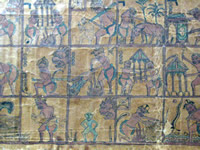 The Balinese wuku calendar is one of the 2 traditional calendars (the other being the Hindu, saka calendar) used to determine the dates for auspicious events, such as ceremonies. The wuku calendar, also called the uku, or pawukon, uses the 210 day lunar cycle. Intricately designed, this calendar divides the days into weeks that are 1 to 10 days in length. All the weeks operate concurrently, each having a special name. Every day, of every week also has a special name. Each one of the 30 7-day weeks also has its own name.
The Balinese wuku calendar is one of the 2 traditional calendars (the other being the Hindu, saka calendar) used to determine the dates for auspicious events, such as ceremonies. The wuku calendar, also called the uku, or pawukon, uses the 210 day lunar cycle. Intricately designed, this calendar divides the days into weeks that are 1 to 10 days in length. All the weeks operate concurrently, each having a special name. Every day, of every week also has a special name. Each one of the 30 7-day weeks also has its own name.
Balinese priests are expert in analysing this system and the Bali Museum has a wonderful wuku calendar on the wall, each day represented with its own picture, depicting various daily scenes. This calendar, when viewed laterally you have the 30 weeks (wuku). Viewed top to bottom, you have the 7 days weeks. The 1st week is called Wuku Sinta, the 2nd week Wuku Landep, the 3rd week Wuku Ukir and so on. The 30th week is called Wuku Watugunung. Each square is painted with a lucky, or unlucky scene, meaning certain activities, such as building a new house, or a cremation ceremony can only take place on special days and weeks.